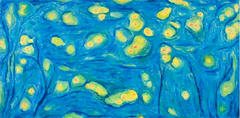Art has always been an inspiration for scientists achieving
great discoveries. One of my favorite examples begins with a
simple question. How would a four-dimensional being see our
world? What would our world look like to a being that could move
through time as easily as we move through space?
They would probably see all three dimensions from all
perspectives at once. Actually it was said that Albert Einstein
often asked the same question in a slightly different way. He
always wondered what would it be like to view the world if you
were riding on a beam of light.
Remember as we move faster and faster toward the speed of light,
at the speed of light we would see everything compact into a
single point and we could see everything at once. But again,
with most great vision and achievements, “to do one must first
imagine.” And just like science fiction art has also inspired
science in many ways.
In fact, while Albert Einstein was asking this very question, a
great artist with no knowledge of Einstein’s work was already
laying the groundwork for his new painting style called
“Cubism.” This artist was none other than Pablo Picasso.
Cubism: A Multi-Dimensional Being's View of our World
In importance, cubism has been compared to the revolutionary
discovery of perspective in the renaissance. In a cubist
painting the solid reality of an object located in space and
fixed in time crumbled away. The visual segments of the front,
back, top and bottom and sides of an object simple jump out and
assault the viewer’s eye simultaneously.
Before this, for example, the different surfaces of a cube would
require an observer to walk around through space to view them in
sequence, and this takes time. But in a cubist painting the need
to walk around an object in space and time is removed and the
collection of visual fragments would let the viewer experience
the entire object from a single point in space and time. Perhaps
the only other place in the universe from which an observer
could actually see these ideas would be from astride a beam of
light.
Monet and Cezanne: Capturing Images that Exist in Time
and Three-Dimensional Space
Before Picasso’s cubism were artists like Monet and Cezanne who
began experimenting with time in art in a very different way.
Monet, who painted the entrance to the Rouen Cathedral in forty
separate works that in essence tried to capture a cathedral that
existed in time as well as in three-dimensional space.
And
Cezanne, who in a single painting, would move in time around the
painting creating work with perspectives that were distorted.
Dali and Escher: Capturing Curved Spacetime and
Manipulating Perspective
After Cubism and Einstein’s discovery many new art techniques
would follow the new physics. Salvador Dali perhaps reflected
the new physics of curved space and time better than any other
artist.
M. C. Escher’s works use a clever manipulation of
perspective. What appears to be correct to the eye, on closer
examination, is wrong.
Escher takes what we think is our clear
understanding of the shape and nature of three-dimensional space
and makes us consider other kinds of geometry.
Constantin Brancusi: Integrating Time in Sculpture
Another great artist, Constantin Brancusi, captured time in his
sculptures in the most remarkable way. One of the most
magnificent collections of his works is located in Romania.
These works show the great river of time turning the wheels of
life in his table of silence which leads to a walkway through
time to the gate of the kiss, a symbol of life, marriage and new
beginnings.
And then on to the never-ending column, a remarkable
work capturing the characteristics of time that both art lovers
as well as physicists could appreciate.
Belbruno - Capturing the Creation of Our Universe in Art

"Cosmic Fireflies" by Dr. Ed
Belbruno |
Artists continue to find new ways to express time in their work.
One of the most interesting people I have met today is Dr. Ed
Belbruno. Dr. Belbruno is an artist, mathematician and
scientist. His paintings reflect a sense of higher reality that
could exist in another dimensional reality or in the universe.
His recent work is towards abstract expressionism that
portrays a fascinating concept that he has recently been able to
translate to the canvas: microwave radiation.
The radiation is left over from the big bang that created our
universe about 14 billion years ago. The radiation has permeated
the universe ever since and it is still lurking, passing through
every being on earth. Ed Belbruno's capture space and time is
truly a unique blend of art, mathematics and science.
Conclusion
is in artistic expressions to capture an image of the
microwave radiation left over from the big-bang creation of our
universe.
To do one must first imagine. There are many more examples where
art and science fiction have intuited science fact. |
|
|
